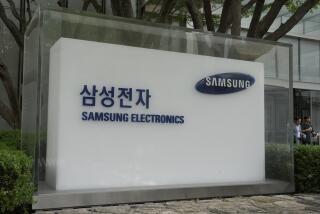Samsung halts Galaxy Note 7 sales after battery explosions

Samsung Electronics is pulling the Galaxy Note 7 smartphone from shelves just two weeks after its launch.
Reporting from SEOUL — Samsung recalled its Galaxy Note 7 smartphones on Friday after finding some of their batteries exploded or caught fire.
Samsung’s Note 7s are being pulled from shelves in 10 countries, including South Korea and the United States, just two weeks after the product’s launch. Customers who have already bought Note 7s will be able to swap them for new smartphones in about two weeks, said Koh Dong-jin, president of Samsung’s mobile business.
He apologized for causing inconvenience and concern to customers.
The recall, the first for the new smartphone, comes at a crucial moment in Samsung’s mobile business. Apple is expected to announce its new iPhone next week, and Samsung’s mobile division was counting on momentum from the Note 7’s strong reviews and higher-than-expected demand.
Samsung said it had confirmed 35 instances of Note 7s catching fire or exploding. There have been no reports of injuries related to the problem.
The company said it has not found a way to tell exactly which phones may endanger users out of the 2.5 million Note 7s already sold globally. It estimated that about 1 in 42,000 units may have a faulty battery.
Samsung’s official statement was silent on whether customers should stop using their phones, and it didn’t say whether the problems happened while the phones were charging or during normal use.
This summer, Samsung ran into a quality-control issue with another smartphone, a niche model called the Galaxy S7 Active. Consumer Reports found that the phone didn’t live up to its water-resistance promises. Samsung said that relatively few phones were affected and that it had identified and fixed the manufacturing problem. Samsung said it would replace a device under warranty if it failed, but it declined to let customers swap phones otherwise or to issue a broader recall.
On the Note 7, after complaints surfaced online, Samsung found that a battery cell made by one of its two battery suppliers caused the phone to catch fire. Koh refused to name the supplier.
“There was a tiny problem in the manufacturing process, so it was very difficult to figure out,” Koh told reporters at a news conference. “It will cost us so much it makes my heart ache. Nevertheless, the reason we made this decision is because what is most important is customer safety.”
Customers’ reports of scorched phones prompted Samsung to conduct extra quality-control tests and delay shipments of the Note 7s this week before the recall.
South Korean high school teacher Park Soo-Jung said she had rushed to buy the new phone, pre-ordering and then activating it on Aug. 19, its official launch date.
The 34-year-old living in the port city of Busan said she was bruised when she rushed out of bed after her phone burst into flames, filling her bedroom with smoke stinking of chemicals.
She said she’s having second thoughts about buying another newly released device, especially after losing all her personal data stored in the destroyed Note 7.
“If the exploded phone had burned near my head, I would not have been able to write this post,” she said Thursday in a popular online forum, where she shared a photo of the scorched Note 7 and described dousing the flames.
China is not affected by the sales suspension. The company said it used a battery made by another supplier for the Note 7s sold in China.
ALSO
Congressman calls on Japanese prosecutors to probe Olympus over scope infections
After SpaceX rocket crisis, Elon Musk also faces Tesla safety and cash-flow issues
Stocks notch tiny gains, starting September on a quiet note
UPDATES:
10:25 a.m.: This article has been updated with additional information.
This article was originally published at 2 a.m.
More to Read
Inside the business of entertainment
The Wide Shot brings you news, analysis and insights on everything from streaming wars to production — and what it all means for the future.
You may occasionally receive promotional content from the Los Angeles Times.










